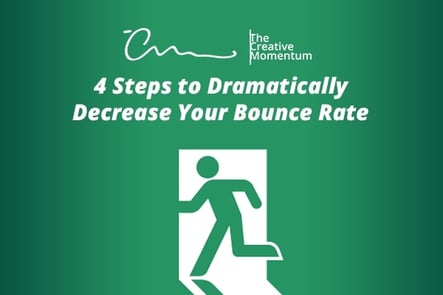
Let’s say your last marketing campaign has increased your traffic by 15%. Along with the 15% increase in traffic, you’ve seen a 15% increase in your bounce rate. Was your SEO marketing campaign a success? Are you calculating bounce rate as a major KPI?
What is Bounce Rate and Why is it Important?
What is bounce rate? Essentially, the bounce rate of your website or webpage is the percentage of people who click through to your site and do not interact with your site before “bouncing” out of your site.
What that means is that the higher the bounce rate, the less likely your users will convert.
How Do I Decrease My Bounce Rate?
If a high bounce rate means less conversions, then our obvious response would be to immediately decrease the bounce rate as much as possible in the quickest way possible.
Here are 4 steps to follow to decrease your bounce rate:
Rid Your Site of Anything That Disrupts the User’s Experience
What does this mean? It means that you need to shift to your focus to the user experience. Oftentimes, we want users to interact the way we intended. Get out of this mindset and start optimizing for the user’s experience.
You can optimize the user’s experience by:
- Fixing your page load speed: The internet is all about speed. If you don’t believe me, ask anyone on the street if they’d go back to dial-up or 3G internet if it was free. The fact that most Americans are willing to pay for high-speed internet & LTE lets us know that page load speed is a big deal. In fact, page load speed is probably one of the top reasons why users bounce out of websites.
- Avoiding Pop-Up Ads: They say that marketers ruin everything. This is often true. Why are we still placing pop-up ads on our sites? And why are sites still littered with banner ads? Marketers have been so bad about this for so long that Banner Blindness is now a real thing.
- Avoiding Over-Aggressive Lead Capturing Strategies: This is very similar to the last point that I made. I know that it’s popular to add email capture pop-ups to your site but it’s causing user friction. The more user friction on your site, the more likely users will bounce out. Serve the content as-is and find more creative ways to optimize your CTA.
Make Your Call to Action Clear
Your call-to-action (CTA) must be clear and easy to spot. You can have amazing content but if users aren’t directed to make any kind of action, then the natural reaction is to bounce out. A good example of this is Dictionary.com. Dictionary.com provides the best content for users who are looking for definitions. However, their pages lack a clear CTA and the result is a high bounce rate. This isn’t a knock on Dictionary.com, it’s just the nature of their niche. However, this goes to show us that if we don’t intentionally try to drive users to take action, they will likely bounce out. Make you call to action clear, however as mentioned above, don’t be overly aggressive.
Fill Your Site With Fresh Content
It is believed that Google uses “freshness” as a ranking signal. Google does this because they know how important it is to the user experience. When users return to your site for the second, third, or maybe twentieth time, they are looking for new content. YouTube has based their entire business around the idea of incentivising their users to produce fresh content in order to draw users and increase interaction. Imagine if YouTube was static for a whole year. Eventually users will drop off and bounce rate will increase dramatically. In conclusion, be intentional about creating fresh content.
Attract the Right Users
To decrease bounce rates, you need to attract the right users. Attracting the right users is far more important than attracting more users. Why would you want to attract users who have no interest in your business anyway? Attracting the wrong users just means that your cost-per-conversion is increasing along with your bounce rate.
You can attract the right users by:
- Being honest in writing your meta description and title: Don’t be deceptive. Users will bounce out if your content does not agree with the reason they clicked through to your website.
- Enhance your targeting: If you’re running AdWords or ads on social media, make sure that you’re targeting the right demographic. I know you want to cast a wide net, but it is better to focus on a demographic that will convert or find your content interesting.
Bounce rate plays a major factor in the success of your marketing campaign. Spend more time improving the user experience on your site, making sure the call-to-action is clear, fill your site with fresh content, and attract the right users. I also want to add that above all of these actions, you should worry about your content the most. Make sure that you’re providing your audience with content that is valuable. As your content becomes more valuable, bounce rate decreases.

